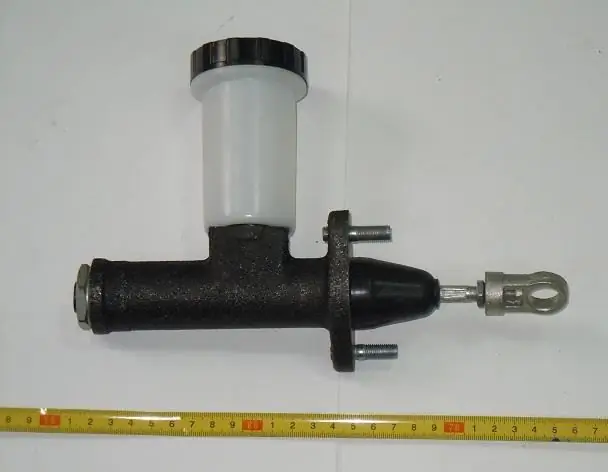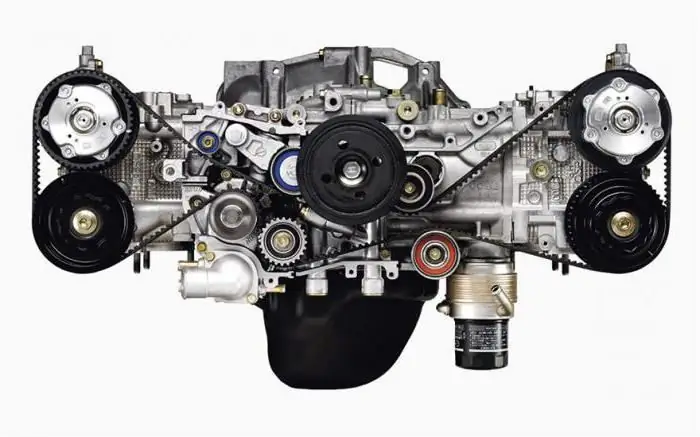2025 Author: Erin Ralphs | [email protected]. Last modified: 2025-01-22 21:14:17
Pneumatic cylinder is one of the components of the pneumatic drive, designed to move the working body of various machines and mechanisms.
Pneumatic cylinder design
The design of a pneumatic cylinder, unlike rotary actuators, is much simpler and consists of a hollow sleeve, inside which a rod moves under pressure of compressed air, creating a retracting and pushing effect on the mechanism.

Snubbers are used to reduce shock loading at the end of the stroke. If the impact energy is small, then this role is assigned to rubber rings. In large cylinders, a system is used to remove part of the air with its further withdrawal through the throttle.
Varieties of cylinders according to the principle of operation
Pneumatic cylinder, depending on the principle of operation, can be of several types:

- The above is a single-acting cylinder.
- Double-acting cylinder you can see in the photo below.

The design of a single-sided cylinder implies the presence of only one inlet, respectively, the mechanism makes the working stroke only in one direction, unlike a double-sided cylinder. The double-ended cylinder has inlets on both sides, allowing for two-way stroke.
Varieties of cylinders by the number of piston positions
Pneumatic cylinder is divided into several types depending on the end position of the piston:
- Two-position, having two fixed extreme positions.
- Multi-position, in which the working mechanism can be fixed in different positions between two extreme positions.
Design features of cylinders
Pneumatic cylinders, depending on the purpose, may differ in design and execution of its individual elements.

For example, double-acting rod actuators are used in mechanisms that require high resistance to side loads. This is ensured by fastening the rod to two supports located at a great distance from each other.
Pneumatic cylinder with anti-rotation stem is used when a tool is attached to it. Special flat chamfers, clinging to the guide element, limit the maximum allowable torque.
Flat designs equipped with flattened sleeves are used to save installation space andto protect the cylinder body from turning.
Tandem cylinder is used to increase the force while maintaining the sleeve diameter. The design of such cylinders consists of two cylinders aligned in the longitudinal plane, having a common rod. Pressure is simultaneously applied to the cavity of the parts, which makes it possible to double the force on the rod.
The current position of the cylinder is determined by special magnetic rings. Electromagnetic sensors record their position and, accordingly, the fact that the rod is in a certain place.
Pneumatic cylinder operation principle
The operation of the pneumatic cylinder is based on the action of compressed air on the piston of the pneumatic cylinder. The impact can be either unilateral or bilateral. Depending on this, pneumatic cylinders are of two types - single-acting and double-acting.
With unilateral exposure, the impact of the air flow is carried out only in one of the working cavities of the mechanism, respectively, the piston moves under the influence of compressed air in only one direction. In the opposite direction, the piston moves by means of a spring, which is installed inside the second working surface on the cylinder rod.
Single-sided pneumatic cylinders fall into several categories: normally extended and normally retracted.
The movement of the rod in double-acting pneumatic cylinders is carried out in two directions by means of the action of compressed air, which is supplied to one of the working areas. Air is distributed between the cavities whenvalve assistance.
Features of the structure of pneumatic cylinders

Pneumatic brake cylinder consists of sleeve, rod piston, rod itself and flanges. Each of the listed elements has its own design features, which determine how the pneumatic cylinder will function. Detailing of such details is carried out after clarification of all design features.
Pneumatic cylinders are made of smooth pipes or profiled pipes, which include aluminum alloys. The main difference between these two parts is the presence of special grooves in the profiled pipe, which are intended for mounting reed sensors.
Pneumatic cylinder pistons are equipped with magnetic rings that interact with reed switches.
The main design feature of pneumatic cylinder flanges is an adjustable damper.
The surface of the flange is protected from possible piston impacts by means of a brake mechanism located at the end of the stroke. This mechanism is, in fact, a damper. The braking speed is controlled by a throttle built into the cylinder flanges.
Pneumatic cylinders, drives in most cases are selected using the calculation method. In addition, special computer programs are often used for this purpose.
The calculation method is based on the force that develops in the stem of the part. It depends directly on the piston diameter, friction forces and operating pressure. When determining the theoretical force, only the axial force on the fixed rod is considered without taking into account friction forces. The force on the stem is different for double-acting cylinders in extension and retraction and for single-acting cylinders with spring return.
Pneumatic brake boosters
Pneumatic boosters are used to convert the energy of compressed air into the required fluid pressure in the hydraulic brake drive.

To improve the reliability of the brake system on many vehicles, the pneumatic booster is installed in two copies by the main brake cylinder. The front actuates the brakes of the front axle, the rear, respectively, the rear axle.
Pneumatic boosters are removed from the vehicle and disassembled only for maintenance or troubleshooting.
Recommended:
12 cylinder engine: types, specifications, operation procedure

On modern cars, multi-cylinder designs are often found. They help to achieve higher power vehicles. Such motors are used both in military equipment and in passenger cars. And although recently heavyweight 12-cylinder engines have been replaced by lighter mechanisms with 6-8 cylinders each, they are still in demand in the automotive industry
Pneumatic suspension on "Sable": description, photo, specifications

Sable is a fairly common car in Russia. In fact, this is the "younger brother" of the GAZelle. This machine has been produced since the late 90s. The suspension of the "Sable" is similar to the GAZelevskaya. The front can be springs or coil springs. But behind the Sobol, a purely spring, dependent suspension is installed. She behaves harshly in the pits. In addition, when fully loaded, the machine sags a lot. How to solve this problem? Many decide to install air suspension
Clutch master cylinder. "Gazelle": device and repair of the clutch master cylinder

To set the car in motion, it is necessary to transmit torque from the engine to the gearbox. Clutch is responsible for this
Pneumatic tires: types, design, application

One of the main components of the wheels of any car are pneumatic tires. They are mounted on the rim and provide high-quality contact with the road. When the vehicle is moving, the tire absorbs vibrations as well as vibrations from driving over bumps in the road. Thus, the tire provides comfort and safety. They make different types of tires. They differ in materials, chemical composition, physical properties
Eight-cylinder (V8) engine: specifications, features

Specifications and features of V8 engines are quite simple. From the history of the first developments to today's powerful V8 engines - just one step

